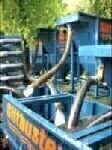Water/Wastewater
Siltbuster Plans to Foil the Grout Escape
Aug 12 2008
In order to strengthen the existing ground, Pulverised Fuel Ash (PFA) from Aberthaw Power Station, is pumped into the old mine workings under the site to form a solid foundation for the planned development.Mr Lynn Parfitt, Site Agent for Alun Griffiths said: “The PFA is mixed with cement in a liquid form and put down the holes to flow into the open mine. The grout then fills the old workings and underpins the footprint of the planned retail park.
“As we are operating on top of an old mine, the Environment Agency (EA) had concerns about grout leaking into the nearby River Ebbw. They requested contingency measures be put in place to trap any high pH grout in the event of an escape through the fissured mine workings. They were worried that the grout, being pumped approximately 1000 metres down into the site, would find its way into the local river.â€
Siltbuster began working on a solution to the grout issue and prepared a contingency plan to meet the EA regulations. “As the PFA, a by-product of burning coal from the power station, is classed as a controlled waste, we had to meet the necessary requirements set by the EA in order to obtain a license and that`’s why we called in Siltbuster,†continued Mr Parfitt.
Project consultants Arup estimated that up to 300m3/hr of contaminated high pH water could make its way into the River Ebbw via the old mine
workings and some means of preventing this was the challenge set to Siltbuster. Trapping a high volume of solids laden water was only one part of the task Siltbuster had to solve, one that was readily achievable by the company`s range of Mobile Silt Traps.
However, as the use of acid to lower the pH was ruled out from the start, potentially treating a high volume of high pH water to get it to a standard suitable for discharge to the river required some radical thinking.
Carbon dioxide (CO2) gas provided the solution to the problem and Siltbuster deployed two of its’ own CO2 dosing systems to treat the water onsite.
Siltbuster Director, George Anderson explained, “We find that for projects such as this carbon dioxide is a real alternative to acid for pH adjustment.
It`s easier to control and intrinsically safer than acid dosing, as it is difficult to reduce the pH level of water to less than around 6 when using CO2.
Coupled with the fact that it`s readily available from gas stockists in an easily transportable form, means we can deploy the technology almost anywhere around the country.
“In line with all our other equipment, our CO2 dosing system is easily transportable and consists of a Carbonator unit, which dissolves the CO2 under pressure in a side stream, before releasing it back
into a main treatment unit at less than 1 bar, forming micro fine bubbles which react with the water and reduce the pH. Six Siltbuster units and two CO2 dosing systems were placed downstream of the construction site at an old adit which flows directly into the River Ebbw. “Regular pH readings are taken every 30 minutes through the works and if the alkalinity of the river rises above a pH of 9.5 the Siltbuster pumps are activated, the water treated and discharged through the Siltbuster treatment plant to the river.â€
Events
IWA World Water Congress & Exhibition
Aug 11 2024 Toronto, Canada
Aug 25 2024 Stockholm, Sweden and online
Sep 03 2024 Mexico City, Mexico
Sep 03 2024 Mexico City, Mexico
Sep 03 2024 San Diego, CA, USA



..jpg)









